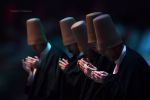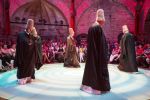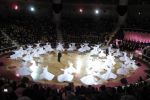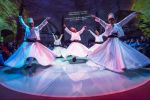| Tour Code | : | PER012IST |
| City | : | ISTANBUL |
| Tour Name | : | Whirling Dervishes Ceremony |
| Tour Dates | : | SEE CALENDAR BELOW |
| Duration | : | AKŞAM | 19:00 - 20:00 |
| Available Languages | : | EN |
SEMA CEREMONY - A SPIRITUAL JOURNEY OF DERVISHES, WHIRLING FOR DIVINE LOVE
Make your own way to the show venue
The Mevlevi Sema Ceremony represents the mystical journey of man’s spiritual ascent through mind and love to perfection.
It is one of the most important heritages of Turkish Culture as a tradition of 800 years old. This unique traditional ritual had been proclaimed as Intangible Heritage of Humanity by UNESCO in 2005.
Come, come again, whoever you are, come!
Heathen, Fire Worshipper or Idolatrous, come!
Come even if you broke your penitence hundred times,
Ours is a portal of hope, come as you are!
Mevlana Celaleddin-i Rumi
WHERE TO WATCH WHIRLING DERVISHES IN ISTANBUL? | There are few places in Istanbul the Rumi Mevlevi performance can be watched.
The Galata Mevlevi House Museum, or tekke, is undoubtedly the most famous Mevlevi Whirling Dervish hall located in Galipdede Street, not far from Tünel, at the end of Istiklal Street. The original building was constructed by Divane (Semai) Mehmed (Chalabi) Dede, Sheikh of Afyon Mevlevi House in 1491 during the reign of Sultan Bayezid II. The building was destroyed by 1509 earthquake, also frequently referred as “little doomsday” and later, by big fire of 1765. It has undergone numerous changes and restorations and was reopened in its present form in 2010.
Unfortunately, the ceremony takes place here on Sundays only, at 17:00. You can only buy tickets on location starting Saturday around noon. With a maximum capacity of 150 people, the performance is often sold out.
The other popular place is the Hodjapasha (Hocapaşa) Cultural Centre located in the building of the 15th century Turkish bath at the centre of Historical peninsular near Sirkeci Train Station, formerly also known as the Orient Express Train Station. It was originally built by Hoca Sinan Paşa who was a teacher and later vizier to Fatih Sultan Mehmet during 1470’s. It was a double bath for both men and women. It was comparatively a big bath with high dome, made of cut stone and also corner walls were designed like a peacock tail. This building served as a Turkish bath till 1988.
Hodjapasha Cultural Centre has two sections. First is an exhibition and foyer area. The other section is performance area which has a circular glass dance floor and a musicians’ stage. Spectators’ seats are located around circular dance floor and have a capacity of 220. Perfect lighting and beautiful decoration turns this historical building to a very mystic place.
The Rumi Mevlevi performance takes place here daily between 19:00 and 20:00 and this is where we invite you to visit.
|
MEVLANA CELALEDDIN-I RUMI | Mevlana Celaleddin-i Rumi is a 13th century Muslim saint and Anatolian mystic known throughout the world for his exquisite poems and words of wisdom, which have been translated into many languages. The United Nations declared 2007 The Year of Rumi and celebrations were held worldwide.
Mevlana was a Muslim, but not an orthodox type. His doctrine advocates unlimited tolerance, positive reasoning, goodness, charity and awareness through love. To him all religions were more or less truth. Mevlana looked with the same eye on Muslim, Jew and Christian alike. His peaceful and tolerant teachings have appealed to men of all sects and creeds. In 1958, Pope John XXIII wrote a special message saying: “In the name of the Catholic World, I bow with respect before the memory of Rumi.”
Mevlana died on 17 December 1273 and was laid to rest beside his father in Konya, in present day Turkey. A splendid shrine, the Mevlana Mausoleum was erected over their remains, which is now a museum and place of pilgrimage. Every year on that day, at this magnificent 13th century mausoleum his followers celebrate Seb-i Arus, his “Wedding Day”, together with thousands of people from all around the world.
According to Mevlana's teachings, human beings are born twice, once of their mothers and the second time of their own bodies. The real birth is the second, spiritual birth. Mevlevi dervishes, guided by a spiritual leader, are expected to live as members of the Mevlevi Order, according to the principles of his teaching. A long period of spiritual progress is necessary before they can participate in the whirling dance, for which they wear a tall cap symbolizing the tomb of carnality, and a white robe which is its shroud.
Those who live this celebration every year and also those experiencing it for the first time, were given at least a taste of the beauties and wonders of loving God, of wanting to be with God eternally.
|
SUFISM AND DERVISHES | The origin and roots of Sufism lie in the life and practices of the Prophet of Islam and the Qur’an. Sufism espouses a well-founded and thoroughgoing interpretation of Islam, which focuses on love, tolerance, worship of God, community development, and personal development through self-discipline and responsibility. A Sufi’s way of life is to love and be of service to people, deserting the ego or false self and all illusion so that one can reach maturity and perfection, and finally reach Allah, the True, the Real.
The Whirling Dervishes took their name from Jelaleddin Rumi (1207-1273), the mystical poet and great Sufi master, called Mevlana (our leader) by his disciples. Sufis seek a close relationship with God, and for Mevlana it was through chants, prayers, music and a whirling dance.
Through the Whirling Dervishes program we hope to bring to you a hint of one of the remarkable ways of achieving this: the way of Rumi, the great Muslim mystic and poet.
The Order of the Whirling Dervishes is one branch of the vast Sufi tradition of Islam. The universal values of love and service shared by all Sufis are very much relevant to the social and political realities of today, and this ritual, which is only performed by the Order of the Whirling Dervishes, has come to symbolize these values in the hearts and minds of millions throughout the world.
|
FUNDAMENTAL MEANING OF SEMA | THE SEMA RITUAL began with the inspiration of Mevlâna Jalâluddîn Rumi (1207-1273) and was influenced by Turkish customs and culture.
It is scientifically recognized that the fundamental condition of our existence is to revolve. There is no being or object which does not revolve, because all beings are comprised of revolving electrons, protons, and neutrons in atoms. Everything revolves, and the human being lives by means of the revolution of these particles, by the circulation of the blood in his body, and by the rotation of the stages of his life, by his coming from the earth and his returning to it.
However, all of these revolutions are natural and unconscious. But the human being possesses a mind and an intelligence which distinguishes him from other beings. Thus the whirling dervish or semazen, intentionally and consciously participates in the shared revolution of other beings.
Contrary to popular belief, the semazen's goal is not to lose consciousness or to fall into a state of ecstasy. Instead, by revolving in harmony with all things in nature -- with the smallest cells and with the stars in the firmament -- the semazen testifies to the existence and the majesty of the Creator, thinks of Him, gives thanks to Him, and prays to Him. In so doing, the semazen confirms the words of the Qur'an (64:1): Whatever is in the skies or on earth invokes God.
An important characteristic of this seven-centuries-old ritual is that it unites the three fundamental components of human nature: the mind (as knowledge and thought), the heart (through the expression of feelings, poetry and music) and the body (by activating life, by the turning). These three elements are thoroughly joined both in theory and in practice as perhaps in no other ritual or system of thought.
The Sema ceremony represents the human being's spiritual journey, an ascent by means of intelligence and love to Perfection (Kemal). Turning toward the truth, he grows through love, transcends the ego, meets the truth, and arrives at Perfection. Then he returns from this spiritual journey as one who has reached maturity and completion, able to love and serve the whole of creation and all creatures without discriminating in regard to belief, class, or race.
|
SYMBOLISM & INTERPRETATION OF SEMA | In the symbolism of the Sema ritual, the semazen's camel's hair hat (sikke) represents the tombstone of the ego; his wide, white skirt represents the ego's shroud. By removing his black cloak, he is spiritually reborn to the truth.
At the beginning of the Sema, by holding his arms crosswise, the semazen appears to represent the number one, thus testifying to God's unity.
While whirling, his arms are open: his right arm is directed to the sky, ready to receive God's beneficence; his left hand, upon which his eyes are fastened, is turned toward the earth. The semazen conveys God's spiritual gift to those who are witnessing the Sema.
Revolving from right to left around the heart, the semazen embraces all humanity with love. The human being has been created with love in order to love. Mevlâna Jalâluddîn Rumi says, All loves are a bridge to Divine love. Yet, those who have not had a taste of it do not know!
|
THE SEVEN PARTS OF SEMA RITUAL | Part One - Testifying to God Unity
The dervish with his headdress (his ego's tombstone), his white skirt (his ego's shroud) is removing his black cloak spiritually born to the truth, he journeys and advances there. At the onset and each stop of the Sema, holding his arms crosswise he represent the number one, and testifies to God's unity. While whirling his arms are open, his right hand directed to the skies ready to receive God's beneficence, looking to his left hand turned toward the earth, he turn from right to left around the heart. This is his way of conveying God's spiritual gift to the people upon whom he looks with the eyes of God. Revolving around the heart, from right to left, he embraces all the mankind, all the creation with affection and love… It starts with an eulogy Nat-I Serif to the Prophet, who represents love, and all Prophets before him. To praise them is praising God, who created all of them.
Part Two - Drums; God Order to the Creation
A drum voice, symbolizing God order to the Creation: ''Be''.
Part Three - Ney; The Divine Breath
An instrumental improvisation taksim with a reed ney. It represents the first breath which gives life to everything.
Part Four - Greeting
The dervishes greetings to each other and their thrice repeated circular walk Devr-i Veled, with the accompaniment of a music called peshrev. It symbolize the salutation of soul to soul concealed by shapes and bodies.
Part Five - Sema; Whirling
It consists of four salutes or Selams. At the end of each as in the onset, the dervish testifies by his appearance to God's unity.
- The first salute is man's birth to truth by feeling and mind. His complete conception of the existence of God as Creator and his state of creature.
- The second salute expresses the rapture of man witnessing the splendor of creation, in front of God's greatness and omnipotence.
- The third salute is the transformation of rapture into love and thereby the sacrifice of mind to love. It is a complete submission, it is annihilation of self with in the loved one, it is unity. This state of ecstasy is the highest grade in Buddhism, defined as Nirvana and in Islam Fenafillah. However, the highest rank in Islam is the rank of the Prophet, he is called God's servant first and his messenger afterwards. The aim of Sema is not unbroken ecstasy and loss of conscious thought. At the termination of this salute, he approves again by his appearance, arms crosswise the Unity of God, consciously and feelingly.
- The forth salute: Just as the Prophet ascends till the Throne and then returns to his task on earth, the whirling dervish reaching the state of Fenafillah, return to his task in creation, to his state of subservience following the termination of his spiritual journey and his ascent. He is a servant of God, of his Books, of his Prophets and all his creation.
Part Six - Prayer; Reading of Quran
Ends with a reading of the Quran and especially of the verse from sura Bakara 2, verse 115:
Unto God belong the East and the West, and whither over ye turn, you are faced with Him.
He is All-Embracing, All-Knowing.
Part Seven - Fatiha
Recitation of the Fatiha, or first chapter of the Kur'an, in memory of all prophets, martyrs and believers, followed by a prayer for the welfare of the nation and its leaders
|
INCLUDES
- Return transportation to/from the pier by fully air-conditioned, non-smoking vehicle
- Entrance fee to the ceremony
- Free Multilanguage explanation booklet
- Free Refreshment including tea, Turkish Coffee, water and juice
EXCLUDES
- Any personal expenses
- Pick-up / drop-off from/to the hotels
- Any extras like DVD, etc.
NOTES
- Children under the age of 7 are not accepted
- Seats are numbered, first booked first served
- Sema is a spiritual act; so please DO NOT applaud, drink or eat while watching. You may do so after the dervishes leave the stage
Perfomance Calendar:
- February: Tue, Thu, Sat
- March, June, July, August:Tue, Wed, Thu, Sat, Sun
- April - May, September - October: Daily
Transfer from hotel to the venue & vs. IS NOT included albeit it can be booked additionally at the cost of €65 per vehicle / return
|
Book, Starting From
0 € per person
|

















